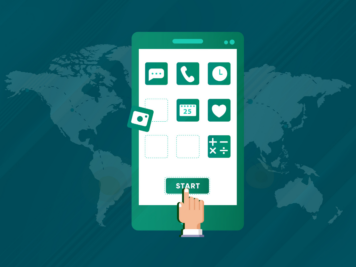Smartphones dominate our waking hours, yet many businesses still grapple with keeping customers engaged with their mobile apps. Mobile app engagement is an important metric to understand app performance as it directly impacts user retention, customer satisfaction, and, ultimately, app revenue. While app store optimization and promotions can boost downloads, turning those users into loyal, engaged participants demands a well-crafted strategy.
The true potential of mobile apps lies in their distinctive features, such as gamification or personalized push notifications. Brands that successfully integrate these elements create personalized and relevant experiences that people value. However, in a market saturated with apps, only 3% of consumers feel they need more apps. That makes standing out even more important.
My time with mobile app development has helped me develop eight strategies that can increase mobile app engagement and the number of engaged brand advocates. But before discussing these strategies, let’s go through some effective ways through which you can measure your mobile app engagement.
Measuring mobile app engagement: Key metrics and insights
Application engagement metrics offer valuable insights into how users interact with an app. These can help you with product decisions like new feature implementation, changes to existing features, etc. Here are a few effective ways to measure app engagement.
Analytics
Analytics data offers comprehensive insights into user behavior, including how they interact with the application, demographic details, crash rates, performance across various devices, average session duration etc. There are several free-to-use services available to track and analyze the analytic data.
User retention rate and churn rate
User retention is the data on how many new users continue to use the application over a specific period. This data can be broken down into different time frames, such as one-day retention, one-week retention, one-month retention, etc.
It is a percentage value. If the number of installs at the beginning of the period is X and the number of active users at the end of the period is Y, it will be (Y/X)%. For example, if the number of installs at the start of a month is 10000 and 1000 users remain at the end of the month, the retention rate would be 10%.
The churn rate is the inverse of the retention rate and reflects the proportion of users who uninstall your app over a given time period. If the number of installs at the beginning of the period is X and the number of active users at the end of the period is Y, the churn rate will be (X – Y)/X x 100. If I take the above example where users dropped from 10000 to 1000, the churn rate will be 90%.
Daily active users and Monthly active users
Daily active users, or DAU metric, represent the number of users who use the app daily, and Monthly active users, or MAU, represent the number of users who use the app monthly. Both metrics are crucial for understanding user engagement and assessing how effectively your application is capturing and retaining user interest over time.
Session length
Session length is the time a user is using your app. It is the time between opening the app and closing it. This metric can vary based on the type of application; for instance, games typically have longer average session lengths compared to payment apps. Generally, a longer session length is favorable as it suggests that users are more engaged with the app’s content and features.
Drop-offs and conversion rates
‘Drop-offs’ refers to when users stop a task. For example, you might want to track the users who purchase an item after clicking on a push notification. If the push notification was delivered to X number of users and Y users purchased the item, Y/X is called the conversion rate. By tracking these metrics, you can identify where users are dropping off and make improvements to enhance the user journey for that specific process.
AppStore and PlayStore reviews
User reviews are valuable for understanding how end users interact with your app. Monitoring reviews on platforms like the Play Store and App Store helps identify issues, gather feedback, and gauge overall user satisfaction. This information can be used to address problems and make improvements based on real user experiences on different devices.
How to increase mobile app engagements
Here are the 8 strategies to boost mobile app engagement:
Onboarding experience
Onboarding screens are designed to introduce users to an app’s features and provide a first impression of the app. A good onboarding experience can increase the retention rate. It shouldn’t be a detailed how-to guide, but it should quickly help users understand the features and usage of the app.
You can have different types of onboarding screens, e.g., a couple of screens at the startup to familiarize new users with the app features, popup screens to explain the new feature that was added in recent updates, popup to explain the reasons before asking permission, etc. We can also use animations, videos, etc., to make it more interactive. A good onboarding experience can increase retention and engagement of users which will help in driving business revenue.
Gamification:
Gamification is the way to add gaming features to an app to increase user engagement. For instance, a fitness app can offer badges on reaching certain steps per day, or a leaderboard of step counts with your friends. These elements can enhance user motivation, extend engagement, and decrease the likelihood of app uninstalls. Here are a couple of gamification ideas you might consider:
a) Rewards:
Integrating a rewards system with coins or points can significantly boost user engagement in your app. Users can earn these points by completing tasks like daily logins, achieving specific goals, or participating in challenges. These points can be redeemed in several ways, e.g., brand gift cards, premium content unlocking, discount coupons, in-app upgrades, etc.
b) Badges:
You can award badges to users for completing specific activities or reaching milestones, such as course completion, achieving fitness goals in a fitness app, and social engagement, e.g., sharing content on social media, following a specific number of users, etc.
c) Leaderboard:
Leaderboard can motivate users to compete for higher rankings. For example, a fitness app or a betting app can have a leaderboard. You can also offer coins or points to the top-position users. Applications can also host challenges with extra rewards. This improves engagement and retention since users will keep returning to the app regularly to check current positions. Leaderboard creates a competitive environment that encourages regular app use.
d) Levels:
Levels start from easy to hard. On each level, users are required to complete certain tasks and completing one level will open another level. Users will return to the app to reach for high levels which increases the retention. For example, a language learning app can add levels with different complexity tasks. A structured levelling system can create a continuous journey of learning and achievement that encourages users to return to the app.
By integrating these gamification strategies, you can enhance the user experience and create a more dynamic and engaging app.
Targeted and personalized push notifications
We can’t send push notifications to all users. The app needs to ask the user for push notification permission, and push notifications will be delivered only to those users who have accepted it. To boost user retention, it’s crucial to time these notifications well and ensure they contain relevant content.
One key benefit of push notifications is their ability to reach users even when the app is not actively running on their device. You can send general push notifications to inform all users of news or new updates. Additionally, you can use targeted and personalized push notifications to enhance user engagement based on their specific preferences and behaviors.
Targeted push notifications are messages sent to a specific segment of app users based on criteria like app version, device type, location, etc. Here are a few examples of how you might use targeted push notifications:
- A new feature is launched exclusively for Android users and you can use targeted push notifications to send notifications to all Android users to inform them about the new functionality.
- If you have a special offer that is only applicable to a specific country, you can send targeted push notifications exclusively to the users located in that country.
- You want to notify all previous version users that a new version is available.
Personalized push notifications are sent to individual users with customized content. Here are some examples of how you can use personalized push notifications:
- If a user has left the cart without placing an order, we can send one push notification to that user with an offer or coupon code to finalize the order.
- Food ordering applications can send push notifications to users around the time when the user typically places orders. This message can be customized with the user’s favorite item or the most frequently ordered dish.
- Music streaming applications can send push notifications featuring personalized playlists based on the user’s listening history.
Personalized push notifications are more effective than generic messages because they cater to individual user preferences and behaviors, leading to higher engagement and improved retention.
A/B testing
If you are releasing a new feature and not sure how it will perform, you can use A/B testing or split testing. This technique involves comparing two or more versions of a feature to determine which performs better. It will randomly divide the users into groups and release different versions of the feature to each group.
Example of features includes onboarding and signup forms, placement of CTAs, placement of ads etc. You don’t need to release multiple versions of the app to test different features. The app bundle will include all different features and on runtime it will decide which one to pick for the user.
Add sharing features
Add a sharing feature to encourage social sharing. Make the flow easy for users to share with their friends on social media apps. It is free marketing for your app. It can increase organic downloads, which in turn improves app store rankings. Use it in different places where users are more likely to share it with others, e.g., when a user owns rewards or on completing certain goals or on achieving milestones, etc.
Incorporate an “invite friends” feature that allows users to refer others to try your app using a unique referral code. Users can invite other users to try the app with a referral code, and when new users join with that code, you can give rewards to both users. You can increase the reward amount if someone invites more than 10 users, 20 users, etc. This tiered approach can motivate users to invite more friends.
Track crash rates and performance of the app
Given the wide variety of devices on the market, the app might perform differently on different devices. Even if the app was tested properly on different devices before a release, we should always monitor the app’s performance on users’ devices after the launch. Users are likely to uninstall apps that are slow or frequently crash
Crash rates and performance are also considered as ranking factors by the Google Play store and Apple AppStore. If your app consistently performs poorly, it will likely be ranked lower in search results, leading to a decrease in organic installs. Hence, performance issues and crashes are essential for maintaining a positive user experience and improving your app’s visibility and download rates.
Add In-app customer support
In-app support provides a convenient way for both new and existing customers to reach out to your team. If they encounter any issues or have any questions, they can use this feature to contact your team. This method is more efficient than sending an email, as messages are sent directly within the app.
Once they get back any response, the app can show a push notification i.e. even if the app is closed, the user will be notified. You can also consider implementing a chatbot to answer commonly asked questions, reducing wait time for users. If you have a customer support team, you can also use live chat for customers. Incorporating these features can significantly boost the app’s reliability and user satisfaction.
Take feedback
Gathering and acting on user feedback is essential for boosting app engagement. Regularly ask your customers what they like/dislike and what features they’d like to see in future updates. You can use surveys or in-app reviews to gather feedback.
Feedback can help you refine existing features and generate ideas for new ones. By consistently updating your app based on user feedback, you can enhance user satisfaction, attract positive reviews, and drive new downloads through recommendations.
Conclusion
In summary, app engagement is a crucial metric for measuring how much users interact with and enjoy your mobile app. High engagement indicates that users find your app useful and are more likely to keep using it. This leads to better user satisfaction, positive reviews, stronger brand loyalty, and more downloads through recommendations. By prioritizing strategies that boost engagements, you can help your app stay relevant and successful in a crowded market.








